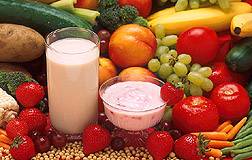Dash – A Diet for Healthy Living
By Lynn Roblin MSc.RD

For many people, “diet” is a four-letter word that conjures up feelings of denial, broken promises and failure. The fact is – most diets don’t work in the long run and most are not suitable for long term compliance or healthy living.
Instead of dieting people should be encouraged to adopt healthier eating and activity habits that help promote lifelong good health. A wonderful new “diet” has appeared on the scene which we can embrace as a sensible and healthful diet. The DASH diet is practical, easy to follow and its success has been proven.
The DASH (Dietary Approaches to Stop Hypertension) diet evolved from a research study designed to test the effect of dietary patterns on blood pressure. Researchers found that a diet reduced in total and saturated fat and rich in fruits, vegetables and low-fat dairy foods significantly lowered blood pressure
The diet was as effective as anti-hypertension medications in lowering blood pressure.
The results of the DASH diet study have important public health implications. Widespread adoption of a DASH-type diet could help reduce the incidence of high blood pressure and prevent coronary heart disease and strokes.
Proven strategies to lower blood pressure such as cutting back on salt, losing excess weight, exercising regularly and reducing alcohol intake (in heavy drinkers) are still critical to lowering blood pressure. However, the DASH study shows that eating the right foods is just as, if not more, important.
The DASH diet is based on choosing a set number of servings from various foods groups. These servings are for a 2000 calorie diet, suitable for an adult woman who does not exercise regularly. The number of servings of foods can be increased or decreased depending on calorie needs, which vary according to age, gender, size and activity level.
Grain Products: 7-8 servings per day
One serving equals 1 slice of bread, 1/2 to 1 1/4 cup ready-to-eat cereal or 1/2 cup cooked rice, pasta or cereal. Food choices include whole wheat bread, English muffin, pita bread, bagels, high fibre cereals, and oatmeal.
Vegetables: 4-5 servings per day
One serving equals 1 cup raw leafy vegetable, 1/2 cup cooked vegetables or 6 oz vegetable juice. Food choices include tomatoes, potatoes, carrots, peas, squash, broccoli, turnip greens, collards, kale, spinach, artichokes, beans and sweet potatoes.
Fruit: 4-5 servings per day
One serving equals 1 medium fruit, 1/4 cup dried fruit, 1/2 cup fresh, frozen or canned fruit or 6 oz fruit juice. Food choices include apricots, bananas, dates, grapes, oranges, orange juice, grapefruit, grapefruit juice, mangoes, melons, peaches, pineapples, prunes, raisins, strawberries and tangerines.
Low fat milk products: 2-3 servings per day
One serving equals 1 cup milk or yogurt or 1 1/2 oz cheese. Food choices include skim or 1% milk, skim or buttermilk, fat free or low fat yogurt, part-skim mozzarella cheese, lower fat cheese.
Meat, poultry and fish: 2 or less servings of per day
One serving equals 3 oz cooked meat, poultry, or fish. Select lean choices with visible fat removed and skinless poultry. Broil, roast, or boil, instead of frying.
Nuts, seeds and cooked beans: 4-5 servings per week
One serving equals 1 1/2 oz or 1/3 cup nuts, 2 tablespoons seeds or 1/2 cup cooked beans. Food choices include almonds, filberts, mixed nuts, peanuts, walnuts, sunflower seeds, kidney beans, black beans, chick peas, soy beans, navy beans, lentils.
Fats: 2-3 servings
One serving equals 1 tsp soft margarine, 1 tbsp low fat mayonnaise, 2 tbsp low fat salad dressing, 1 tsp vegetable oil. Fat content changes serving counts for fats and oils. For example, 1 tbsp of regular salad dressing equals 1 serving, 1 tbsp of low fat dressing equals 1/2 serving, and 1 tbsp of fat free dressing counts as 0 serving.
Sweets: 5 servings per week
One serving equals 1 tbsp sugar, 1 tbsp jelly or jam, 1/2 oz jelly beans, 8 oz lemonade.
Tips on eating the DASH way:
- Start small. Make gradual changes in your eating habits.
- Centre your meal around carbohydrates such as pasta, rice, beans or vegetables. Treat meat as one part of the whole meal, instead of the focus.
- For desserts and snacks, eat fruit or low-fat, low-calorie foods such as sugar-free gelatin.
Remember: If you use the DASH diet to help prevent or control high blood pressure, make it part of a lifestyle that includes choosing foods lower in salt and sodium, keeping a healthy weight, being physically active and drinking alcohol in moderation.
The DASH research centers included the Brigham and Women’s Hospital in Boston, Center for Health Research in Portland, Duke University Medical Center in Durham, John’s Hopkins University in Baltimore, and Pennington Biomedical Research Center in Baton Rouge. The U.S. National Heart, Lung and Blood Institute was a partner in the research and provided funding for the study.
For more information on the DASH diet check out the web site at: www.nhlbi.nih.gov/hbp/prevent/h_eating/h_eating.htm

